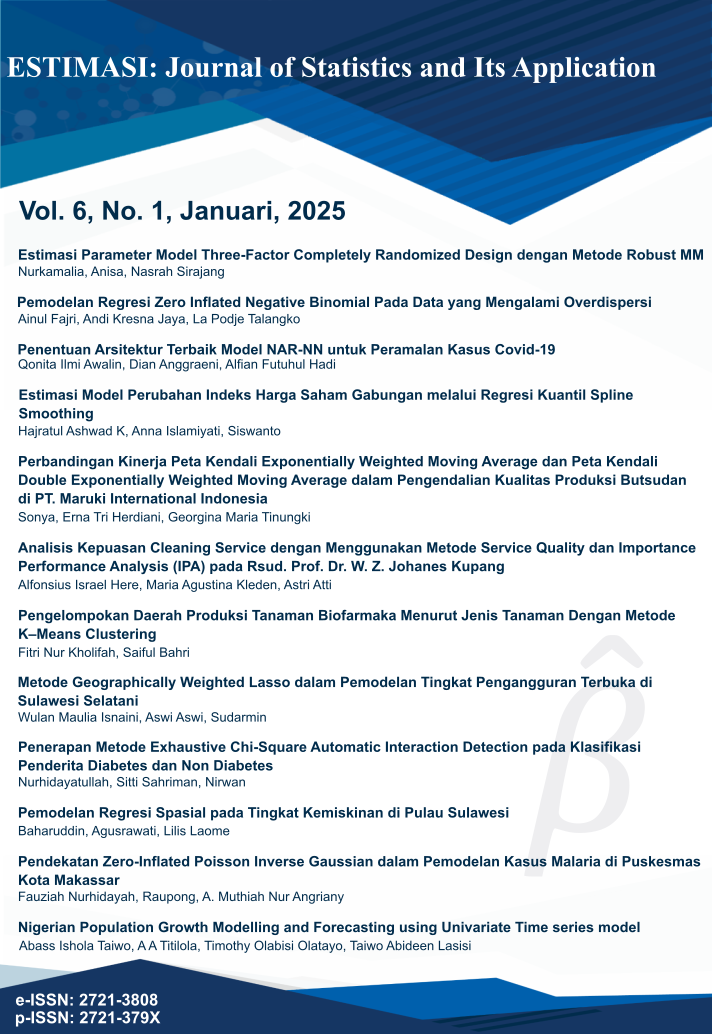Perbandingan Kinerja Peta Kendali Exponentially Weighted Moving Average dan Peta Kendali Double Exponentially Weighted Moving Average dalam Pengendalian Kualitas Produksi Butsudan di PT. Maruki International Indonesia
DOI:
https://doi.org/10.20956/ejsa.v6i1.25751Keywords:
ARL, EWMA, DEWMA, Shift Mean Process, Control ChartAbstract
Quality control is an effort in the production process to maintain product quality and minimize the occurrence of defects. One of the quality control tools is a control chart. An exponentially weighted moving average (EWMA) control chart is used to detect small shifts in the process mean. The result of the development of the EWMA control chart is the double exponentially weighted moving average (DEWMA) control chart, which increases the exponential smoothing process, where the control chart is considered more sensitive in detecting small shifts in the process mean. This study aims to obtain a comparison of the performance of the EWMA and DEWMA control charts in controlling the quality of butsudan production at PT. Maruki International Indonesia. The results obtained show that the DEWMA control chart has better performance in detecting small shifts compared to the EWMA control chart based on the smallest ARL value, at λ=0.1 the DEWMA control chart has an ARL value 1.1363 which is smaller than the ARL of EWMA control chart is 1.2268.
References
Montgomery, D. C. Pengantar Pengendalian Kualitas Statistik (Yogyakarta). Universitas Gajah Mada, 1990.
Hamsah, L., Purnamasari, I., & Satriya, M. A. Penerapan Peta Kendali Exponentially Weighted Moving Average (EWMA) dan Peta Kendali Double Exponentially Weighted Moving Average (DEWMA) dalam Pengendalian Kualitas Produk Mie pada UD. Sinar Sulawesi. Prosiding Seminar Nasional Matematika, Statistika, dan Aplikasinya, 222–230, 2019.
Montgomery, D. C. Introduction To Statistical Quality Control 6th Edition. Arizona State University: John Wiley & Sons, Inc, 2009.
Adeoti, O. A. On Control Chart for Monitoring Exponentially Distributed Quality Characteristic. Transactions of the institute of Meassurement and Control, 1-11, 2019.
Hakam, M. Perbandingan Grafik Kendali CUSUM (Cumulatif Sum) dan EWMA (Exponentially Weighted Moving Average) dalam Pengendalian Kualitas Produksi Pipa Besi pada Pt. Pacific Angkasa Abadi. Surabaya: Institut Teknologi Sepuluh Nopember, 2017.
Hamsah, L., Purnamasari, I., & Satriya, M. A. Penerapan Peta Kendali Exponentially Weighted Moving Average (EWMA) dan Peta Kendali Double Exponentially Weighted Moving Average (DEWMA) dalam Pengendalian Kualitas Produk Mie pada UD. Sinar Sulawesi. Prosiding Seminar Nasional Matematika, Statistika, dan Aplikasinya, 222–230, 2019.
Nelwati, Hazmira, Y., & Maiyastri. Peta Kendali Exponentially Weighted Moving Average (EWMA) untuk Jumlah Wisatawan yang Berkunjung Ke Sumatera. Jurnal Matematika UNAND, 4(4), 83–90, 2019.
Adji, M. H. S., Soehardjoepri, Widjajati, F. A. Analisa Proses Produksi Wheeldops PT. Morodadi Prima dengan Data Tidak Normal Menggunakan Peta Kendali Exponentially Weighted Moving Average (EWMA) dan Peta Kendali Double Exponentially Weighted Moving Average (DEWMA). Jurnal Sains dan Seni ITS, 8(1), 2019.
Adeoti, O. A., & Malela-Majika, J. C. Double Exponentially Weighted Moving Average Control Chart with Supplementary Runs-Rules. Quality Technology & Quantitative Management, 1–24, 2019.
Montgomery, D. C. Introduction Statistical Quality Control 7th Edition. New York; John Wiley & Sons, Inc, 2012.
Kalgonda, A. A., Koshti, V. V., & Ashokan, K. V. Exponentially weighted moving average control chart, Asian Journal of Management Research, 2, 253-263, 2011.
Herdiani, E. T., Fandrilla, G., & Sunusi, N. Modified Exponential Weighted Moving Average (EWMA) Control Chart on Autocorrelation Data, Journal of Physics: Conference Series, 1-7, 2018.
Adeoti, O. A. A new double exponentially weighted moving average control chart using repetitive sampling. International Journal of Quality & Reliability Management, 35, 387-404, 2016.
Downloads
Published
Issue
Section
License
Copyright
It is the author's responsibility to ensure that his or her submitted work does not infringe any existing copyright. Authors should obtain permission to reproduce or adapt copyrighted material and provide evidence of approval upon submitting the final version of a manuscript.


